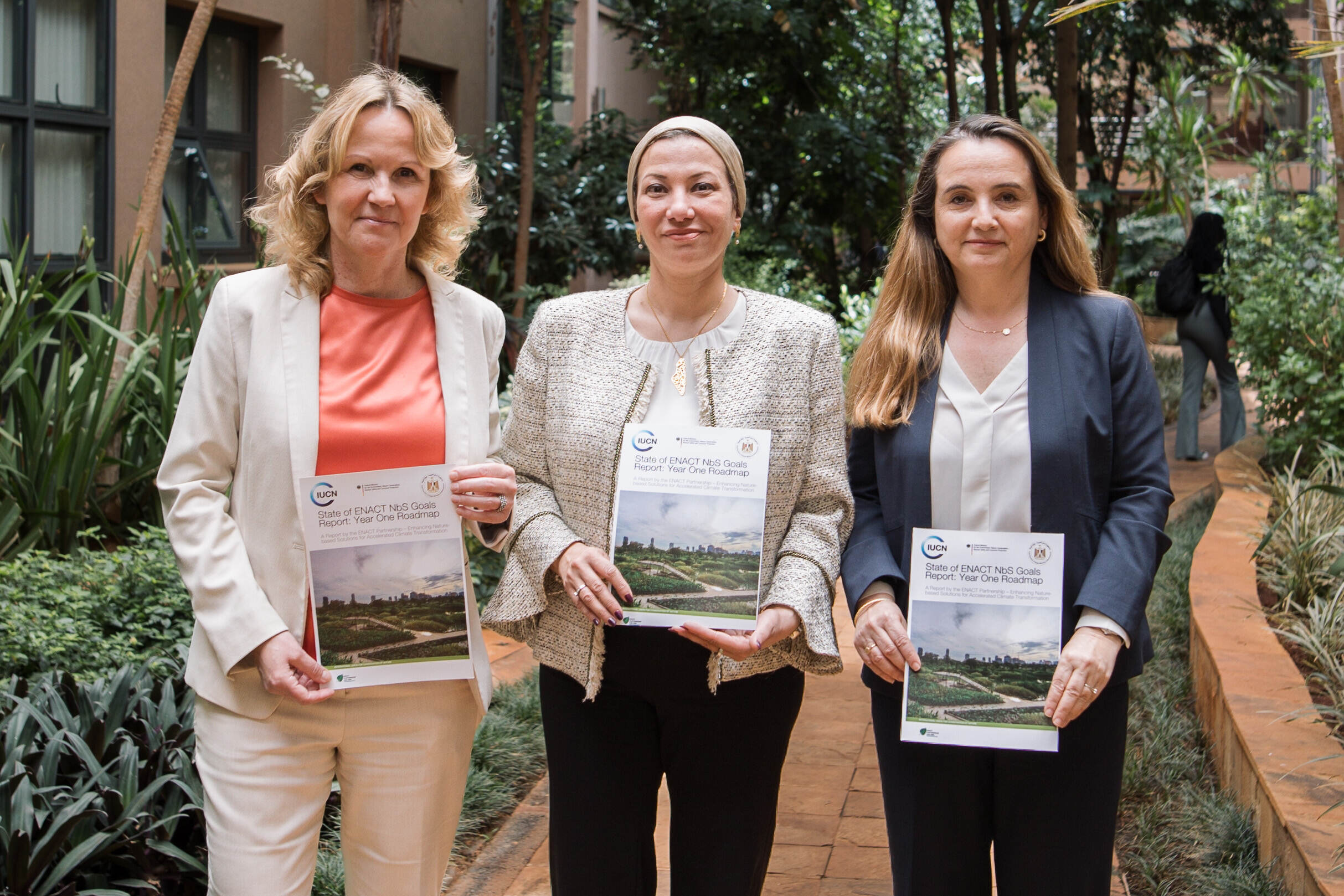Global partnership to advance Nature-based Solutions pushes for integrated actions to fight climate
Nairobi, Kenya, 1 March (IUCN) – A new report from the ENACT Partnership released today during the Sixth Session of the United Nations Environment Assembly (UNEA-6) concludes that the global community must better integrate actions on climate change, biodiversity loss, and land degradation to best support human well-being, and that governments must increase efforts to implement Nature-based Solutions that can help with all three of those pressing challenges.
 From left: Steffi Lemke, Federal Minister for the Environment, Nature Conservation, Nuclear Safety and Consumer Protection, Federal Republic of Germany; H.E. Dr Yasmine Fouad, Minister of Environment, Arab Republic of Egypt; and Dr Grethel Aguilar, IUCN Director General, holding copies of the new report on Nature-based Solutions from the ENACT Partnership.
From left: Steffi Lemke, Federal Minister for the Environment, Nature Conservation, Nuclear Safety and Consumer Protection, Federal Republic of Germany; H.E. Dr Yasmine Fouad, Minister of Environment, Arab Republic of Egypt; and Dr Grethel Aguilar, IUCN Director General, holding copies of the new report on Nature-based Solutions from the ENACT Partnership.
Photo: BMUV/Sascha Hilgers
“The interconnected crises of climate change, biodiversity loss, and land degradation significantly threaten human equality and well-being. It is no longer tenable to address these crises separately,” said Dr Grethel Aguilar, IUCN Director General.
“The need to integrate approaches and strengthen synergies across global biodiversity and climate frameworks through NbS is why Egypt during its presidency of COP27, alongside Germany and with the support of IUCN, launched the ENACT Partnership at COP27 in November 2022,” said H.E. Dr Yasmine Fouad, Minister of Environment, Arab Republic of Egypt.
“The report lays the foundation for achieving the vision of the ENACT partnership to enhance the accessibility of the best available science for NbS and build coherence around social and environmental safeguards to ensure both long-term success and increased investment in NbS,” said Minister Fouad.
“I am very pleased that we are presenting the first report of the ENACT Partnership today. Faster, better implementation of Nature-based Solutions is needed around the world. The ENACT Partnership can play a key role here. As an alliance of government and non-governmental stakeholders, the primary goal of ENACT is to improve cooperation and financing. Alongside Egypt, Germany has supported and co-chaired the initiative from the beginning. We are advocates for nature-based solutions nationally and internationally. The UNEA resolution on Nature-based Solutions for Supporting Sustainable Development demands it,” said H.E. Steffi Lemke, Federal Minister for the Environment, Nature Conservation, Nuclear Safety and Consumer Protection for the Federal Republic of Germany.
The conclusions are contained within the “State of ENACT NbS Goals Report: Year One Roadmap”, the first summary of the year-old ENACT Partnership, which stands for Enhancing Nature-based Solution for an Accelerated Climate Transformation. The ambitious global Partnership is co-chaired by Egypt and Germany and composed of member-states including Canada, Malawi, the United States of America, the Republic of Korea, and others.
The ENACT Partnership aims to employ Nature-based Solutions, or NbS, to enhance the protection from and resilience to climate impacts of at least 1 billion vulnerable people, secure up to 2.4 billion hectares of ecosystem integrity, and significantly increase global mitigation efforts through protecting and restoring carbon-rich ecosystems.
But despite widespread recognition of the value of NbS – which work with nature, instead of against it – to address the interlocking three global crises, the ENACT report stresses that government efforts and funding have to be better aligned and coordinated to fully unleash their benefits.
“Despite commitments toward integration made under these agreements, governments and funders continue to provide investments in a siloed fashion,” says the report. “Meaning funds and efforts directed at addressing climate change do not always include assurances for enhancing ecosystem integrity nor human well-being.”
In one example of how a country is adopting the right approach, the report cites Canada, which has not only increased its investment in fighting climate change by $315 million, but has also entered a three-year partnership with IUCN to leverage their tools and expertise on NbS for climate and biodiversity.
The ENACT report also says that governments have to support whole-of-government approaches to bring NbS into the mainstream, support the development of global NbS indicators and tools for to track progress towards goals, ensure that NbS is placed at the centre of how resources are mobilised for developing countries, and prioritise increases in funding aimed at women and Indigenous Peoples.
The report makes clear that the success of ENACT in achieving its vision for increased coherence on NbS across the Rio Conventions will only be possible based on the committed participation of its partners and the promotion of cooperation at regional and global levels. Moreover, the report calls for all states and organizations who are not formally a partner of ENACT to join and encourages those with the capacity to support elements of the Partnership’s work plan and objectives to do so.
“The report offers an important reminder that sustainable development requires holistic approaches and collaboration, and that this collaboration is possible with the right vision,” said Dr Aguilar.
More than 2 million research papers have disappeared from the Internet
An analysis of DOIs suggests that digital preservation is not keeping up with burgeoning scholarly knowledge. A study identified more than two million articles that did not appear in a major digital archive, despite having an active DOI.Credit: Anna Berkut/Alamy
A study identified more than two million articles that did not appear in a major digital archive, despite having an active DOI.Credit: Anna Berkut/Alamy
More than one-quarter of scholarly articles are not being properly archived and preserved, a study of more than seven million digital publications suggests. The findings, published in the Journal of Librarianship and Scholarly Communication on 24 January1, indicate that systems to preserve papers online have failed to keep pace with the growth of research output.
“Our entire epistemology of science and research relies on the chain of footnotes,” explains author Martin Eve, a researcher in literature, technology and publishing at Birkbeck, University of London. “If you can’t verify what someone else has said at some other point, you’re just trusting to blind faith for artefacts that you can no longer read yourself.”
Eve, who is also involved in research and development at digital-infrastructure organization Crossref, checked whether 7,438,037 works labelled with digital object identifiers (DOIs) are held in archives. DOIs — which consist of a string of numbers, letters and symbols — are unique fingerprints used to identify and link to specific publications, such as scholarly articles and official reports. Crossref is the largest DOI registration agency, allocating the identifiers to about 20,000 members, including publishers, museums and other institutions.
The sample of DOIs included in the study was made up of a random selection of up to 1,000 registered to each member organization. Twenty-eight percent of these works — more than two million articles — did not appear in a major digital archive, despite having an active DOI. Only 58% of the DOIs referenced works that had been stored in at least one archive. The other 14% were excluded from the study because they were published too recently, were not journal articles or did not have an identifiable source.
Preservation challenge
Eve notes that the study has limitations: namely that it tracked only articles with DOIs, and that it did not search every digital repository for articles (he did not check whether items with a DOI were stored in institutional repositories, for example).
Nevertheless, preservation specialists have welcomed the analysis. “It’s been hard to know the real extent of the digital preservation challenge faced by e-journals,” says William Kilbride, managing director of the Digital Preservation Coalition, headquartered in York, UK. The coalition publishes a handbook detailing good preservation practice.
“Many people have the blind assumption that if you have a DOI, it’s there forever,” says Mikael Laakso, who studies scholarly publishing at the Hanken School of Economics in Helsinki. “But that doesn’t mean that the link will always work.” In 2021, Laakso and his colleagues reported2 that more than 170 open-access journals had disappeared from the Internet between 2000 and 2019.
Kate Wittenberg, managing director of the digital archiving service Portico in New York City, warns that small publishers are at higher risk of failing to preserve articles than are large ones. “It costs money to preserve content,” she says, adding that archiving involves infrastructure, technology and expertise that many smaller organizations do not have access to.
Eve’s study suggests some measures that could improve digital preservation, including stronger requirements at DOI registration agencies and better education and awareness of the issue among publishers and researchers.
“Everybody thinks of the immediate gains they might get from having a paper out somewhere, but we really should be thinking about the long-term sustainability of the research ecosystem,” Eve says. “After you’ve been dead for 100 years, are people going to be able to get access to the things you’ve worked on?”
spring talk from great british nature writer sir john lister kaye
One of Britain’s best-known conservationists, John Lister-Kaye, described by Springwatch’s Katie Humble as ‘joyful and inspirational’, gives a rare glimpse into his intriguing life and work at a literary talk and book signing at the Royal Scots Club on 23rd March, 10:30am-12:30pm.
Entry is free and there will be a pop-up Toppings bookstall.
A true naturalist, John Lister-Kaye patiently and meticulously observes and records the lives, habits and habitats of otters, badgers, weasels and pine martens. Hours of careful waiting and watching in the woods and loch, the river, fields and moorland is rewarded with insight into how these animals live when unhindered by human interference; sometimes red in tooth and claw, but often playful, familial, curious and surprising.
John’s own journey from aristocratic roots to being captivated by the creatures of Scotland and becoming one of the most respected academic observers of the natural world gripping too.
During deep dives exploring natural history, familial characteristics and ecological significance, he began to find the animals were ‘teaching me to become feral myself, guiding me into their ways so that my senses seemed to merge with theirs at a level far more intimate than just scientific interest or admiration.’ His new book, FOOTPRINTS IN THE WOODS, The Secret Life of Forest and Riverbank, is not only a love letter to these elusive animals and what he describes as the ‘irresistible wildness’.
His new book, FOOTPRINTS IN THE WOODS, The Secret Life of Forest and Riverbank, is not only a love letter to these elusive animals and what he describes as the ‘irresistible wildness’.
It is also a timely reminder of the fragility of habitat and the beauty and variety we have to lose if we don’t choose to actively protect it.
‘A peerless observer who is as much a part of the land as his beloved badgers. This, unusually, is nature writing that is actually about nature rather than the writer, and so it has the power and wisdom of the hills and forest. Marvellous’ – CHARLES FOSTER (Author, Cry of the Wild)
‘No one writes as movingly, or with such transporting poetic skills, about encounters with wild creatures’ – HELEN MACDONALD (Award-winning writer, H is for Hawk)
‘I am addicted to the writings of John Lister-Kaye’ – JOANNA LUMLEY
Sir John Lister-Kaye is one of Britain’s best-known naturalists and conservationists and has spent a lifetime exploring, protecting and celebrating the British landscape and its wildlife.
John came to live in the Highlands of Scotland in 1968 to work with the celebrated author and naturalist Gavin Maxwell of Ring of Bright Water fame.
He is the author of eleven books on wildlife and the environment, including The Dun Cow Rib, shortlisted for the Wainwright Prize, and Gods of the Morning, winner of the Richard Jeffereies Award for Nature Writing.
John has lectured on the natural environment all over the world. He was awarded an OBE for his services to nature conservation, the Royal Scottish Geographical Society’s Geddes Environmental Medal and honorary doctorates from two Scottish universities for his contribution to nature writing.
He has served prominently in the RSPB, the Nature Conservancy Council, Scottish Natural Heritage and the Scottish Wildlife Trust. He lives with his wife and family among the mountains of the Scottish Highlands, where he runs the world-famous Aigas Field Centre. The literary coffee morning with author talk will be held on 23rd March 2024 at The Royal Scots Club, 29-31 Abercromby Place, Edinburgh, EH3 6QE starting at 10:30am.
The literary coffee morning with author talk will be held on 23rd March 2024 at The Royal Scots Club, 29-31 Abercromby Place, Edinburgh, EH3 6QE starting at 10:30am.
There will be an opportunity to purchase books for signing by the author at a pop-up bookshop provided by Topping & Company Booksellers, Edinburgh.
The event is free and is open to all, members and non-members alike, with numbers limited by venue capacity only.
Reservations may be made by via Eventbrite or by emailing The Royal Scots Club on events@royalscotsclub.com
Green Deal: New guidelines for sustainable forest management and payment schemes for forest ecosystem services
The Commission has published the “closer to nature” guidelines and the guidance on payment schemes for forest ecosystem services. Today, the Commission has published two new guidelines to incentivise and reward sustainable forest practices. The “closer to nature” guidelines aim to strengthen forest multifunctionality and resilience to climate change, while fostering long-term economic and other societal benefits. The guidance on payment schemes for forest ecosystem services presents a variety of ways in which land managers, including foresters, may derive monetary benefits from the provision of the different ecosystem services. The two guidelines are key deliverables of the EU Forest Strategy.
Today, the Commission has published two new guidelines to incentivise and reward sustainable forest practices. The “closer to nature” guidelines aim to strengthen forest multifunctionality and resilience to climate change, while fostering long-term economic and other societal benefits. The guidance on payment schemes for forest ecosystem services presents a variety of ways in which land managers, including foresters, may derive monetary benefits from the provision of the different ecosystem services. The two guidelines are key deliverables of the EU Forest Strategy.
EU forests at risk due to lack of diversity
Forests in Europe have been shaped by human intervention for centuries. As a result, structural complexity and species diversity is unnaturally low in many parts of Europe: 75% of forests are even-aged and 1/3 of forests consist of only one species with another 50% limited to 2 or 3 species. Lack of diversity reduces the resilience of our forests. More than 60% of the biomass in European forests is exposed to risks such as fires, pest outbreaks or wind throws, impacting the capacity of forests for wood provision, carbon sequestration or other services.
“Closer to Nature” is an ecosystem-based form of forest management that fosters more heterogeneous and diverse forests and rely less on human intervention. Natural dynamics and structural complexity are determining factors for forest resilience, and adaptive capacity. Forests composed of several tree species, age classes and life cycle stages are more resilient and adaptable to climate change and disturbances than even-aged monocultures and benefit forest functions, services and long-term forest productivity.
Closer to nature forest management also provides the opportunity for tapping into the wider economic potential of forests beyond timber provisions. In addition to wood and non-wood materials and products, forests provide valuable ecosystem services, such as habitats for biodiversity, water purification, flood and climate regulation. Carbon sequestration and non-wood forest products, such as honey, mushrooms or wild meat are marketable sources of income.
The closer to nature guidelines follow from the EU Biodiversity Strategy 2030 and the EU Forest Strategy 2030 and have been developed in close collaboration with Member States and relevant forest actors. The guidelines can be used on a voluntary basis by national and regional forest authorities as well as directly by forest managers who wish to introduce elements of ‘closer-to-nature’ forestry into management practices. They will be made available in all EU languages to facilitate their broad uptake across the EU.
Payment schemes for forest ecosystem services – an alternative option for providing income through sustainable and multifunctional management of forests
Forests not only provide wood and non-wood materials and products, but also multiple other services such as habitats for biodiversity, water purification, and regulation of floods and of climate. They have carbon sequestration and cooling capacities and play a role in providing renewable raw materials, food and medicines. These services are indispensable to fight climate change, transition to a circular bioeconomy and sustain a healthy society.
Despite the actual value of, and increasing demand for, the large variety of forest ecosystem services, wood production remains the main – if not the only - source of income for forest owners and managers. Financial rewards or profits from other ecosystem services are very limited.
This voluntary guidance document aims to provide information and advice that help public and private entities and forest owners and managers develop and implement payment schemes for forest ecosystem services.











































